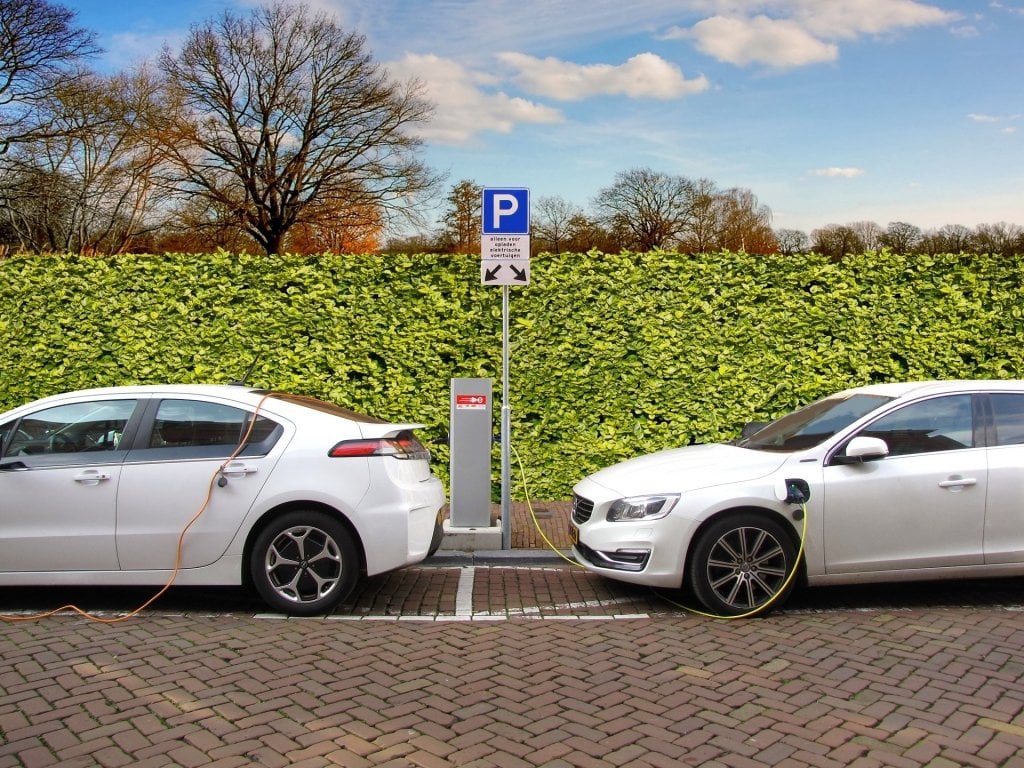
I show how in Europe, an electric vehicle becomes greener after 20 to 40 thousand kilometres of driving, not 700 thousand as a famous Belgian professor calculated on television recently. He has corrected his calculation in a new blog post but in such a confusing way that I feel the need to explain. I also show that in science facts are still facts and Damien Ernst and I actually agree about them: we don’t live in a post-truth world!
NOTE: this post is long and a bit detailed. If you want to read it like a normal blog post you could just read the bold text.
At the core of this discussion is the following problem: electric vehicles emit less CO2 while driving, but they need a battery and producing that battery emits more CO2. How bad is this battery compared to the driving advantage? Two weeks ago the famous and impressive prof. Damien Ernst (Blondel Medal winner, working on supergrids that help to solve the energy transition) calculated – on Television – it would take more than the lifetime of the electric vehicle (697,612 km to be precise) for the electric car to compensate for the global warming caused by battery production.
The number spread like wildfire to dozens of newspapers and blog posts. But it’s patently untrue (as Ernst has admitted) and many people asked me (as a researcher of the Eindhoven University of Technology on this topic) to put the record straight. So I wrote a step by step debunking thread on twitter (even translated to Italian) that inspired blogs (e.g. vrz, autospectrum, tweakers, dvhn, autoblog, vaaju) and I helped multiple newspapers with fact-checks (e.g. de Standaard, Algemeen Dagblad and de Volkskrant). From the Dutch newspapers that reported the error, only the Telegraaf left it uncorrected (which is a pity because they are shrinking but still the biggest).
But now Ernst is back with a new blog post. I felt that his writing is so hard to follow and larded with negative opinions about EVs that most media seem to conclude he halved his number when in fact he has slashed it by 10-20x once you understand what he’s saying. Hence the need for this blog post to set the record straight. I will need to do some untangling and explaining along the way so bear with me.
Before we start: I like and admire the work Ernst is doing. I don’t claim he’s a bad professor and I have no problem whatsoever with him rightly pointing out that driving a large (electric) car is bad for the environment. My reply is all about facts. That’s what I strive for and that’s what science is all about. Ernst agrees: “As I am a scientist, I never hesitate to question anything I had asserted when presented with new information. Such an attitude is at the very core of scientific thought. So, I have redone my calculations below, but integrating the information collected from these ‘attacks’ to expand upon the hypotheses that I used to make my calculations, and even to change one that needs to be changed. I have no problem recognizing this fact.” So this is not a pissing match! It’s a calculation.
Let’s start.
How bad is battery production?
CO2 emitted during battery production causes global warming. Ernst first claimed 312 kg CO2 was emitted for every kWh of battery produced. He now estimates 127 kg. Industry experts put it at 65 kg and it will become less when batteries are produced using renewable energy.
Let’s get the most complicated part out of the way first: how much CO2 is emitted while producing the battery for an electric car?
We describe batteries using kilowatt hour or kWh. One kWh means you can keep an electric motor using one kilowatt (a thousand watt) running for one hour. My first Nissan Leaf had 24kWh but mid-level cars will be gravitating to 60 kWh batteries and the biggest battery you can currently buy is 100 kWh.
A modern car battery weighs about 6 kilograms per kWh. You can reuse that battery between 2 thousand and 10 thousand times before you recycle. (For comparison, a liter of gasoline contains about 10 kWh but you can only use it once and cannot recycle. So currently, 6 kg of batteries replaces 200 to 1,000 liters before recycling.)
Then we measure emissions in kg CO2 per kWh of battery produced. While on TV, Ernst assumed that 312 kg is emitted for every kWh produced. He corrects many mistakes, but this is the only one he admits clearly. He describes how he used a highly theoretical publication about a prototype plant and that the authors of the publication offer a much lower 127 kg CO2 per kWh when production would scale up.
However, even this one clear correction is made harder to understand because he’s interjecting all kinds of attacks on EVs and production in China along the way, saying that in China – because of the coal-heavy electricity mix – the 127 kg would quadruple, followed by: “Long live ‘Made in China’!”
Ernst apparently can’t help himself but actually, there is an article from 2017 specifically about China that puts emissions at 97 kg CO2/kWh: not exactly the quadruple of the 127 kg that Ernst is implying. I think the best and most recent source in the literature (from 2019) pegs it at 106 kg/kWh. And from industry insiders, I hear that large state-of-the-art factories are already at 65 kg/kWh. Hard numbers are hard to come by here but I would say it’s safe to say Ernst’s estimates are still high.
Of course the biggest promise of EVs lies in the future. As mining equipment becomes electric and battery factories increasingly use solar and wind, the CO2 from battery production could become very low. And then batteries have become 50% lighter every 10-15 years and this is bound to continue for some time. E.g. the publication that Ernst uses only applies for batteries that are already about 50% heavier than state-of-the-art batteries. So future batteries will use much less material and be produced with clean electricity. And then: why would you throw away the battery? It’s not like we burned it and blew the results into the air. Second life use as a home battery seems a good idea. And although recycling is still in its infancy because there are few used car batteries yet, it’s widely seen as the future. All-in-all: batteries have the potential to become extremely low in CO2 waste (at least 10x better before 2050 would be my quick estimate) while there is simply very little progress left for gasoline and diesel.
How dirty is electricity?
CO2 emitted during electricity production causes global warming too. For reasons unexplained, Ernst first assumed Belgian electric vehicles drive on German electricity (550 grams/kWh). He now takes the EU mix over the coming ten years that he pegs at 317 grams per kWh. I can explain why he actually means 289 grams.
In the calculation on TV and in the first calculation on his new blog, Ernst takes an electricity mix of 550 grams/kWh. He says this is the energy mix of Germany. But what is not clear is why you should take the German energy mix when making calculations for a Belgian audience and Ernst doesn’t explain. But the Belgian emits only half that (257 grams/kWh) and the European mix is not far behind (296 grams/kWh according to the most up-to-date-source).
I think Ernst could confuse readers when he says in his new blog post “I’ll take a new hypothesis, more positive for the electric vehicle” when he stops using the German mix. I think an easier to understand formulation would be: “I made the mistake of taking the German instead of the Belgian or European energy mix and have corrected that.”
So his “new hypothesis” is that we should look at the EU mix over the coming ten years and that this is 275 grams/kWh.
He then says we must count the losses of charging/uncharging the battery and the losses of the electricity grid. But if I look at his numbers, he is double-counting the charging/uncharging of the battery. Either that or he is comparing with an electric vehicle that is so big you cannot buy it. If I correct the double-counting of charging/uncharging I arrive at 289 grams of CO2 per kWh.
Now I will take this number in my scenarios but I must point out he is being very pessimistic. First, he assumes the electric vehicle will only drive for 10 years. But the average age of cars in the Netherlands is 19.6 years and Tesla batteries can already last longer than that while new batteries degrade much slower still. (I have a Master student studying the latest literature on this at the moment and the gains are astounding.)
Ernst also assumes the European energy mix will not become greener in the coming ten years. I feel I must point out that he is at odds with any energy prediction and energy plan I know of. I would say the average prediction is 200 grams/kWh in 2030.
Don’t forget the production of gasoline
In his first calculation, Ernst forgot to include the CO2 emissions caused by the production of gasoline. He now includes this and it increases gasoline car emissions by 40%.
If Ernst would make these calculations more often he would not have made this beginners error. He is once again confusing his readers by saying this is just “a hypothesis” that is “friendly to the electric vehicle”. But every expert knows that if you include the production of electricity you should also include the production of fossil fuels. So a clearer formulation would be: “I forgot to include the production of gasoline but have added it in my new calculation.”
This actually makes a big difference. The CO2 per liter of gasoline increases from 2.28 kg to 3.2 kg. This means the emissions of the gasoline vehicle increase with a whopping 40%.
How much energy do electric and gasoline vehicles use?
For reasons not explained, Ernst decided to compare a large electric vehicle with a small gasoline car.
This is the strangest correction for me. First Ernst compared a small gasoline vehicle with an average electric vehicle. Now he suddenly decides he wants to compare a small gasoline vehicle with the largest EV he can find. That is, of course, his decision but he is not making this choice clear to his readers I think. So allow me to be clearer.
Ernst takes an electric vehicle that outputs 0.23 kWh/km and compares it with a gasoline car using 6 liter per 100 km.
I have made a little comparison of the energy use of different vehicles on the site of the American Environmental Protection Agency to show how strange this is.
(I use American numbers because the official numbers in Europe are wrong because of the car lobby.)
As you can see 0.23 kWh/km equates to a Tesla Model X: a large SUV. A direct comparison would be a Porsche Cayenne: a bit smaller and slower but close. So a comparable gasoline vehicle would use 11.28 liters per 100 km.
Instead, Ernst compares to a car using 6 liter per 100 km. That’s less than a VW Golf with a small motor and manual transmission.
Ernst’s new conclusion is hard to find
To me, it seems you must be an expert to understand what his new results are.
Drawing a conclusion from all this is straightforward. But Ernst is apparently confusing many readers if I see what they say on Twitter and in newspapers. They think the answer to his calculations can be found under the heading: “And now the calculation!” But at that point in his post, the Belgian/European cars still drive on the coal-heavy German electricity mix (?) while the production of gasoline is still excluded (?). It is not clear to me why you would display the results of these faulty assumptions so prominently.
In the second part he corrects that using the European electricity mix while including gasoline production but puts the results in an unobtrusive paragraph under the new “Hypothesis 5” where he says:
“Let’s try to discuss Hypothesis 1 and Hypothesis 2 again. These two hypotheses lead us to CO2 emissions of the order of 10,153 kg for the manufacture of an 80 kWh battery. As discussed previously, the CO2 emissions associated with battery manufacture can vary quite a bit, depending on where the battery is manufactured. It’s very difficult to get an entirely clear picture of this. I have the impression that, in 2019, we must be somewhere in the range of 8000 kg – 18000 kg of CO2 emitted for the manufacture of 80 kWh batteries. With our new set of assumptions, an electric vehicle with a battery of 80 kWh would begin to have a lower carbon footprint than a petrol-driven vehicle somewhere between 67,226 km and 151,259 km travelled.”
What Ernst is saying in the lower number is: if I correct my mistake of forgetting gasoline production, if battery production is close to my corrected source, if I assume the European electricity mix is not getting cleaner and if I compare a very big EV to a small gasoline car, then the EV is greener after 67,226 km.
The higher number says the same but assumes battery production emits 225 kg CO2/kWh without naming any source.
If you find this confusing: I was confused too.
The Calculations!
Using Ernst’s corrected numbers, a large EV becomes greener than a small gasoline car after 81 thousand km. If you compare like with like the EV becomes greener after about 35 thousand km. Using the best information I have available, I would put it at 19 thousand now and 7 thousand in the future.
It’s not rocket science. Let me show you.
Battery production
If we multiply 127 kg CO2/kWh and 80 kWh we get (and I quote Ernst): “10,153 kg for the manufacture of an 80 kWh battery.” I round Ernst to 10,160 kg of CO2 for the production of the battery
EV emissions while driving
0.23 kWh/km multiplied by 289 grams/kWh means 66 grams of CO2 per km for the EV
Gasoline car emissions while driving 6 liter/100km multiplied by 3.192 kg of CO2 per liter means 192 gr CO2/km for the gasoline car
The result
The EV emits 192 – 66 = 125 gr CO2/km less than the gasoline car. 10,160/0.125 = 81,248 km.
So after 81,248 km, a Tesla Model X is gaining on a small gasoline car using Ernst’s assumption
That was scenario 1 in the table below. But we can also make some other interesting scenarios.
Scenario 2. We could compare the Tesla Model X with a car his own size. Then the Model X is greener than his counterpart (we took the Porsche Cayenne) after 35 thousand km.
Scenario 3. We could compare an electric VW Golf with a gasoline VW Golf using the assumptions of Ernst to get electric is greener after 41 thousand km.
Scenario 4. Again comparing eGolf against gasoline Golf using Ernst his new assumptions but battery production according to the best official sources. This gives 35 thousand km.
Scenario 5. These are my best guess assumptions: battery production based on industry estimates of someone I trust and CO2 emissions over the lifetime of the EV based on mainstream assumptions. Then I get about 19 thousand km before the EV is greener.
Scenario 6. This is the future I’m doing it all for. Mining and production of batteries will use renewable electricity and electric cars will drive on renewable electricity. When that happens they will become greener after 7 thousand km and less than that if the battery was recycled.
Conclusion
Electric cars are really much better for the climate than gasoline or diesel cars, even according to the new calculations from prof. Damien Ernst and certainly according to the most up-to-date information.
PS: I hope everyone understands that video conferencing, electric bikes and trains are better for the environment than large cars, whether electric or not.










